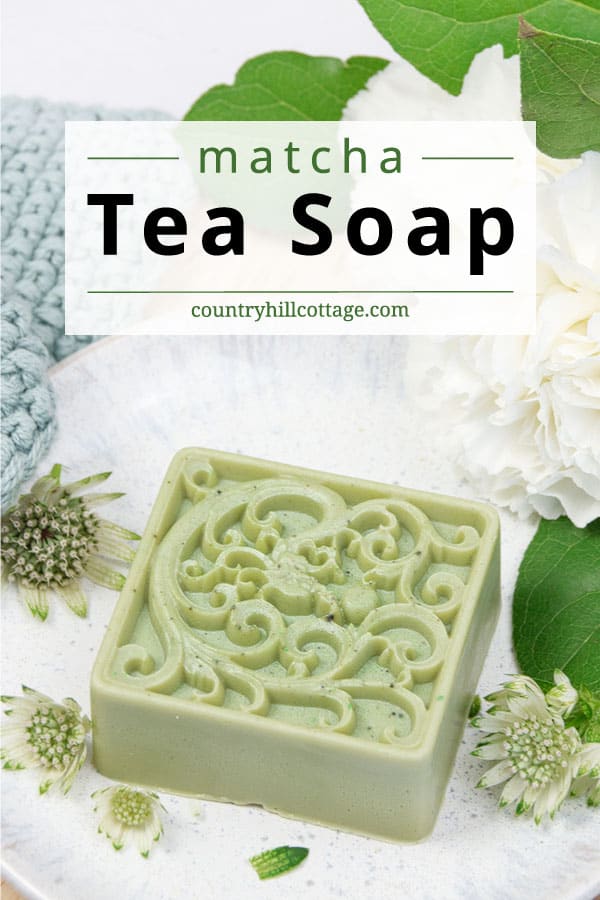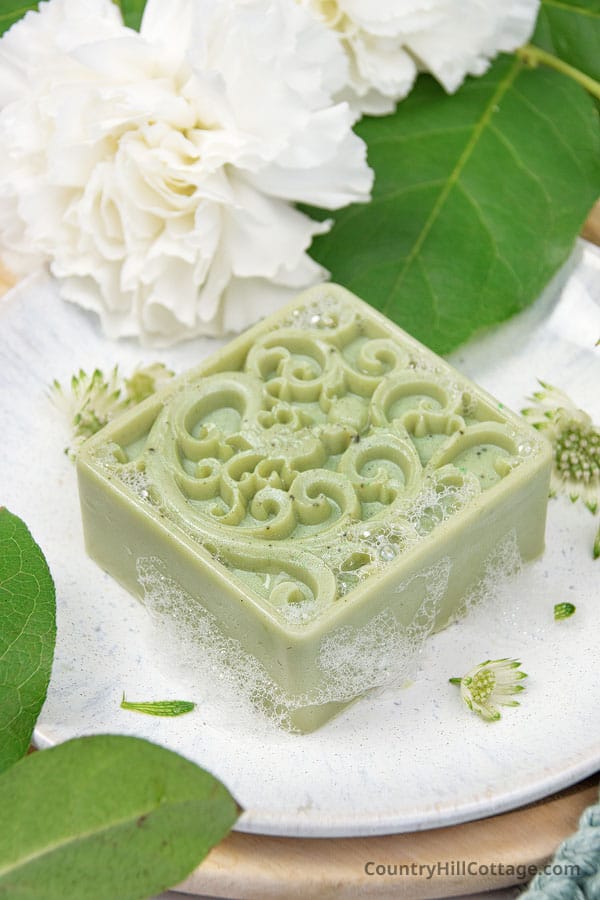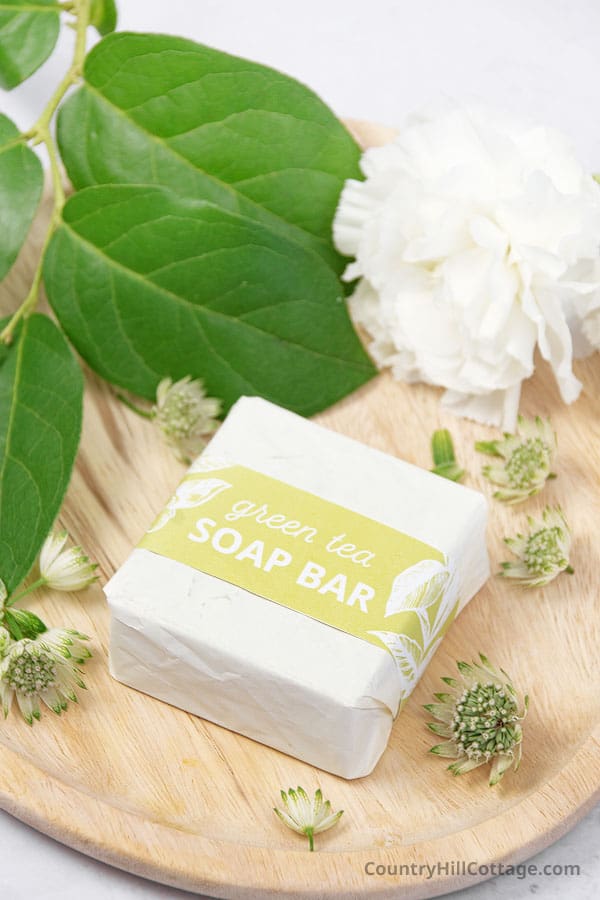This homemade green tea soap recipe is enriched with green tea extract, matcha powder, and a refreshing essential oil blend that provides a natural fragrance and skin-soothing qualities. DIY match soap is simple and easy to make, full of skin-loving antioxidants, and makes a fantastic handmade gift.

Disclosure: This post contains affiliate links, meaning, at no additional cost to you, we will earn a small commission if you click through and make a purchase. Learn more
Homemade green tea soap
Whether your hands need extra love and care, you want to add more anti-aging skincare items to your routine, or you need an easy homemade gift, this matcha green tea soap recipe is the answer! It cleanses gently and leaves your skin feeling soft and refreshed.
The elegant soap is made with a melt and pour soap base and includes 2 forms of green tea. Match powder and botanical green tea extract supercharge the soap with antioxidants and other soothing compounds that nourish your skin.
Essential oils provide natural fragrance and turn this green soap into a little luxury. I’ll show you 3 blends: An intoxicating floral scent with jasmine, a revitalizing mix with lemongrass and citrus oils, and a calming blend featuring blue yarrow and palmarosa.
I love melt and pour soap because it’s beginner-friendly and incredibly easy to use. If you’re looking for some more homemade soap recipes, be sure to try out my eucalyptus soap, lavender soap with honey, or maybe this turmeric soap.

Green tea soap benefits
- Soothing: Green tea is said to calm and protect the skin, balance sebum, and aid with premature skin aging.
- Antioxidants: Green tea is a rich source of antioxidants. These natural compounds fight free radicals and decrease signs of aging, such as hyperpigmentation and fine lines.
- Gentle on the skin: This tea soap produces a creamy lather for a pampering cleansing experience and to moisturize and soften your skin.
- Indulgent scent: My matcha soap is infused with the fresh aroma of essential oils, and I show you different blends to scent your soap.
- Suitable for all skin types: Green tea is safe for your daily skincare and suitable for all skin types.
- Natural ingredients: The soap is made with quality ingredients and enriched with 2 sources of green tea, matcha powder and green tea extract.
- Simple: You won’t have to handle lye with this easy homemade soap recipe because it starts out with a pre-made soap base.

Ingredients and tools
This matcha soap is one of the easiest soap recipes to whip up! Made with just 4 ingredients, it doesn’t get much easier than this. Here’s what you’ll need to make 1 soap bar:
- 4 oz / 115 g melt and pour soap base
- 1/2 tsp / 2.5 g / 0.08 oz green tea extract
- 1/4 tsp / 0.5 g / 0.02 oz matcha powder
- up to 30 drops / 1 g / 0.03 oz essential oils (scroll down for scent ideas)
Soap base
Melt and pour soap is a ready-made soap base, meaning it has already gone through the saponification process. You can choose from a variety of different bases.
You can select any soap base like shea butter, goat’s milk, glycerin, or olive oil for this project. I used a shea butter soap base.
Green tea extract
Next is green tea extract, the most concentrated form of green tea. The botanical extract is an excellent source of antioxidants. Antioxidants reduce oxidative stress on your skin and fight cell damage caused by free radicals.
The topical application of green tea extract can improve various skin concerns and may help with skin aging, increase elasticity, and reduce acne.
Matcha powder
Matcha powder is the finely milled powder of shade-grown tea leaves. Match shares all the benefits associated with green tea and is rich in nutrients and antioxidants.
Ceremonial grade green tea powder is best, but the more affordable culinary grade matcha is also a good option.
Soap making supplies
You also want to assemble the following supplies:
- Soap mold to shape your soap. I bought a soft and squishy silicone mold that produces square soap bars with an intricate filigree design. This rectangular soap mold casts 4-oz soap bars and will work as well.
- Digital scale to measure the ingredients. You can also measure by volume using cups and spoons, but melt and pour soap is tricky to measure correctly with cups.
- Cutting board and paring knife to chop the soap base.
- Microwave safe container to melt the soap base. I used a glass measuring cup.
- Stirrer or spoon to combine the ingredients.
- Oven mitt to protect your hands. MP soap gets quite hot, and I recommend wearing oven mitts to avoid burns.
- High-proof alcohol in a spray bottle (optional) to dissolve bubbles.

Essential oil blends to scent green tea soap
If left unscented, matcha soap has a very faint botanical smell. Of course, I could never resist scenting my homemade soap recipes with essential oils. So, I created 3 blends to complement and highlight the beauty of green tea.
White florals
This elegant essential oil blend features the intoxicating scent of jasmine mingled with rhododendron and a touch of vanilla as a fixative. You’ll need:
- 18 drops jasmine absolute + 8 drops rhododendron + 4 drops botanical vanilla extract
Jasmine absolute is a beautiful and luxurious scent. You can substitute ylang ylang complete as a more affordable alternative.
Spa fresh
The following blend is a revitalizing mix of lemongrass and lime with a fresh hint of lemon. This scent not only smells incredibly refreshing, it also has a mild skin-brightening effect.
- 15 drops lemongrass + 9 drops steam-distilled lime + 6 drops steam-distilled lemon
Be sure to use steam-distilled citrus oils because cold-pressed lime/lemon essential oil can react phototoxic.
Skin-soothing
Is your skin in need of all the love it can get? Then try this fragrant blend with blue yarrow, palmarosa, and cedarwood. It’s very calming and will soothe reddened, rough skin.
- 13 drops blue yarrow + 10 drops palmarosa + 7 drops cedarwood
If you can’t find blue yarrow essential oil, replace it with chamomile or blue tansy essential oil.
Tips for coloring green tea soap
Before sharing here on the blog, I always trial each project several times to ensure it works. When testing this soap recipe with different types of matcha, I noticed that some matcha powders stay bright green, while others oxidize and turn a grey-green color.
I found that ceremonial grade retains its color better than culinary grade, but even then, discoloration can happen.
The discoloration won’t lessen the quality of the soap, and you don’t have to do anything else if it doesn’t bother you.
To create a stable green color that doesn’t fade, tint the soap with a tiny amount green mica or green chrome oxide mineral powder. You’ll need 1/16 tsp or less. This is optional.

How to make green tea soap
Does the thought of making soap at home intimidate you? It really shouldn’t! Follow these simple steps, and you will have gorgeous DIY green tea soap in no time!
Step 1: Melt soap base
- Chop the melt and pour soap base into 0.5 in / 1 cm cubes.
- Put the soap cubes into a glass measuring cup and warm in the microwave in 30-second increments until fully liquid.
- Be careful not to overheat and stir between each heating.
Step 2: Add actives and scent
- Let the soap cool slightly, for about 3 minutes. Green tea extract is heat-sensitive, so it’s important to allow the soap to cool before adding it.
- Once the soap has cooled, slowly stir in the green tea extract and matcha powder until thoroughly combined.
- If using a colorant like mica or green chrome oxide, swirl it in now.
Step 3: Cast soap
- Place the soap mold on a cutting board or plate. This makes it easier to lift and transport the soap.
- Carefully pour the soap mixture into the mold.
- Optionally, spritz the top with alcohol to dissolve bubbles. Feel free to skip this step if the bubbles don’t bother you.
Step 4: Allow setting
- Allow the soap to cool and set at room temperature for approximately 1 hour or 30 minutes in the fridge.
- To see if the soap is ready, gently press your finger at the soap. If it feels solid, you’re good to go. The soap needs to cool some more if you notice softness.
Step 5: Unmold
- Once fully hardened, gently pull the silicone mold from the soap to break the airlock.
- Then carefully unmold your green tea soap bar. Your matcha soap is ready!
Step 6: Store
- Melt and pour soap contains glycerin, a humectant that draws moisture from the air. This moisture can form small beads on the surface of the soap. This effect is called glycerin dew.
- If you don’t plan to use the soap right away, wrap it tightly in plastic wrap/cling film to avoid glycerin dew.

Tips for success
My DIY green tea soap is super simple to make, but these 6 tips will guarantee you beautiful and fragrant green tea soap bars every time!
- Cut the soap into tiny cubes so it melts quickly and doesn’t get as hot.
- Keep an eye on your soap as you melt it in the microwave. Goat’s milk soap, in particular, boils over and burns easily.
- Let the soap cool before adding your actives. Green tea extract is heat-sensitive, and its skincare benefits would be lost if added to hot soap.
- Stir the soap slowly when mixing in ingredients. Mixing too vigorously will aerate the soap and create bubbles.
- Rewarm the soap if it solidifies too early by reheating in the microwave for 15 to 20 seconds. Melt and pour soap can be rewarmed several times.
- Make it more nourishing. If you have dry skin and want an extra moisturizing green tea soap, swirl 1/4 tsp shea butter into the hot soap base until melted.

Matcha soap FAQ
How many soap bars does the recipe yield?
As written, the recipe makes 1 green tea soap bar. The mold I used produces square soap bars that weigh 4 oz / 115 g and are 2.5 in / 6.5 cm in size. The height is 1 in / 2.7 cm.
Double, triple, or quadruple the ingredient amounts to make a larger batch.
What is green tea?
Green tea is derived from the buds and young leaves of Camellia sinensis, the tea plant. Unlike other types of tea, green tea isn’t fermented, which preserves its bright green color and nutrients.
What are the actives in green tea?
The bioactive compounds in green tea are called polyphenols or catechins. Epigallocatechin gallate (EGCG) is one of these actives and benefits the skin and benefits the skindue to its anti-inflammatory and antioxidant qualities.
Green tea also holds tannins and caffeine, which have a stimulating effect, shrink blood vessels, and reduce puffiness.
Can I use green tea soap for my face?
You could use green tea soap to cleanse your face, but I generally don’t recommend using soap on your face.
The pH of soap ranges between 8 and 9. And this alkaline pH can offset the natural pH of the facial skin, which is slightly acidic (pH 5 to 5.5).
Instead, try a gentle cleanser like this exfoliating cleansing balm, DIY oil cleanser, or this homemade face wash.
If you still decide to use it on your face, be sure to apply a toner afterward to reinstate the optimal pH. Try my nourishing green tea toner or this fragrant rose water toner.
Does green tea soap help with acne?
Yes, the soothing and anti-irritant properties of green tea can help to reduce body acne. Green tea also has the ability to regulate oil production and can decrease excess sebum.

Storage instructions
- Packaging: As mentioned, you want to store your green tea bar soap tightly wrapped in plastic wrap/cling film to protect it from humidity.
- Storage: Store your handmade green tea soap at room temperature in a dark, cool location. A cupboard, drawer, or airtight container is a good option. Avoid direct sunlight to maintain the quality of the ingredients.
- Shelf life: The soap should keep well for at least 1 year.
Gifting green tea soap
I think green tea soap makes an excellent gift for clean beauty enthusiasts and everyone who appreciates handmade soap.
To package your soap for gift giving, wrap the soap bar in a piece of brown paper and adorn it with our free printable soap wrapper. You can download the printable at the end of this post.

Green Tea Soap Recipe
This homemade green tea soap recipe is enriched with green tea extract, matcha powder, and a refreshing essential oil blend that provides a natural fragrance and skin-soothing qualities. DIY match soap is simple and easy to make, full of skin-loving antioxidants, and makes a fantastic handmade gift.
Materials
- 4 oz / 115 g melt and pour soap base (any will work, I used a shea butter soap base)
- 1/2 tsp / 2.5 g / 0.08 oz green tea extract
- 1/4 tsp / 0.5 g / 0.02 oz match powder
- up to 30 drops / 1 g / 0.03 oz essential oils (see post above for scent ideas)
- tiny amount green mica (optional, to create a stable green color. Add 1/16 tsp or less.)
Tools
- digital scale or measuring cups and spoons
- cutting board
- paring knife
- glass measuring cup
- spoon or glass stirrer
- silicone mold
- high-proof alcohol in a spritz bottle
Instructions
- Melt soap base. Chop the melt and pour soap base into 0.5 in / 1 cm cubes. Put the soap cubes into a glass measuring cup and warm in the microwave in 30-second increments until fully liquid. Be careful not to overheat and stir between each heating.
- Add actives and scent. Let the soap cool slightly, for about 3 minutes. Green tea extract is heat-sensitive, so it’s important to allow the soap to cool before adding it. Once the soap has cooled, slowly stir in the green tea extract and matcha powder until thoroughly combined. If using a colorant like mica or green chrome oxide, swirl it in now.
- Cast soap. Place the soap mold on a cutting board or plate. This makes it easier to lift and transport the soap. Carefully pour the soap mixture into the mold. Optionally, spritz the top with alcohol to dissolve bubbles. Feel free to skip this step if the bubbles don’t bother you.
- Allow setting. Allow the soap to cool and set at room temperature for approximately 1 hour or 30 minutes in the fridge. To see if the soap is ready, gently press your finger at the soap. If it feels solid, you’re good to go. The soap needs to cool some more if you notice softness.
- Unmold. Once fully hardened, gently pull the silicone mold from the soap to break the airlock. Then carefully unmold your green tea soap bar. Your matcha soap is ready!
- Store. Melt and pour soap contains glycerin, a humectant that draws moisture from the air. This moisture can form small beads on the surface of the soap. This effect is called glycerin dew. If you don’t plan to use the soap right away, wrap it tightly in plastic wrap/cling film to avoid glycerin dew.


















